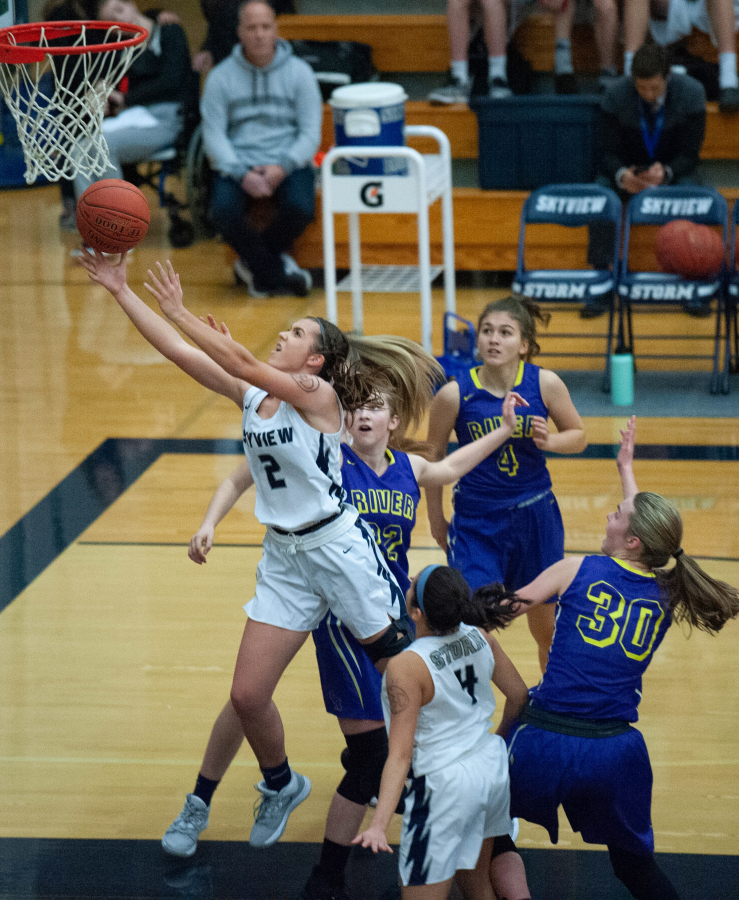Skyview senior Addie MacPherson missed her sophomore basketball season with an ACL injury. Her junior softball season was canceled due to COVID-19. This year, MacPherson again met difficult news when the 4A/3A Greater St. Helens League announced earlier this year that seasons 2 and 3 would merge.
She had a choice: play both basketball and softball in a busy final few months before graduation or choose between two longtime joys. MacPherson will play exclusively softball this spring.
“It was very saddening at the time,” MacPherson explained. “I do love basketball and I do love softball.”
MacPherson is among many local multi-sport athletes who made hard choices this spring. The 4A/3A GSHL started seasons 2 and 3 on Monday. Basketball, swimming, wrestling, bowling, gymnastics, baseball, girls golf, boys soccer, softball, girls tennis and track and field will run simultaneously.
In an effort to ease the burden of choice on athletes, the WIAA granted a one-year exemption for athletes to play multiple sports in a single season.
For MacPherson, playing two sports at once alongside her schoolwork was too much to take on.
“I think it would be hard to maintain doing both sports daily with practices, games, schoolwork and all the other things going on,” MacPherson said. “I think that would have a strong effect mentally and I just don’t think I could have been effective at both sports at the same time.”
Union senior Lolo Weatherspoon was still weighing her options late last week. She’s the leader of a Titans’ basketball team coming off a program-best fifth-place state finish. She is also a talented hurdles runner and high jumper on the track and field team.
“I grew up doing track and it’s been a big part of my life for so long,” Weatherspoon said. “Being one of the leaders (on the basketball team), I need to be there at every practice and I need to have all my energy. … Honestly, I’m not sure what I’ll do.”
While some athletes are opting to focus on one sport this spring, the majority are going forth with two sports.
For Battle Ground girls basketball coach Dave McIntosh, the WIAA exception was key to fielding full teams this spring. Many of his girls play multiple sports in the winter and spring seasons, he said.
One of those is senior Mallory Meyer, a basketball and softball standout.
“I’m really thankful we’re able to do both at once,” said Meyer, who was initially frustrated when the 4A/3A GSHL merged the two seasons without a guaranteed change to the rule that prohibits athletes from competing in multiple sports in the same season. When the WIAA eased the restriction, Meyer was relieved.
“Nobody in their right mind would make people actually choose between one or the other,” she said. “A lot of seniors are wanting to do both and I’m really glad they changed that.”
The majority of athletes and coaches are overwhelmingly grateful for the decision the 4A/3A GSHL administrators made. The 2A GSHL and 1A Trico leagues kept seasons separate, but shorter. Traditional spring sports in the 2A GSHL run through May 8, with winter sports starting May 3.
In the 4A/3A GSHL, which competes through mid-June, teams will have about 70 percent of the games of a normal schedule. In the 2A and 1A, schedules are roughly 50 percent of a normal year. For smaller schools, who typically have more multi-sport athletes and shallower rosters, combining seasons was a greater logistical problem.
“When you compare what we have on our schedule to other leagues in the state, it’s not close,” Union girls basketball and golf coach Gary Mills said. “(The administrators) have done a fantastic job.”
Restrictions
The WIAA’s allowance caps dual-sport athletes at 18 hours of practice and four competitions per week.
For Prairie junior Reece Walling, who plays basketball and baseball, this creates a unique hurdle. He is in constant communication with coaches Kyle Brooks and Cameron Chilcote to figure out which games or practices he can attend.
During the first week, baseball practice runs from 3:15 to 5:30 and basketball goes 5:30 to 7:30.
“I’m just going to have to get my schoolwork done in class as much as I can and really focus to keep my grades up,” Walling said. “Now that I think about it, it is a lot to juggle.”
Walling is getting advice from his father, who was a four-sport athlete in high school, doing swimming and basketball at the same time.
No schedule is set in stone when it comes to Pacific Northwest baseball, but as it stands now, conflicts will be minimal.
“I’m excited for it,” said the Washington State University baseball commit. “With COVID and everything being shut down, I haven’t been able to do a lot for awhile. This gets me out of the house.”
Coach’s challenge
Union girls basketball and golf coach Gary Mills never considered dropping a sport when it was announced the seasons were merging and his teams would be competing at the same time. Mills and Mountain View’s Ben Mathias (bowling, golf) are Clark County’s only two-sport head coaches this spring.
“My first thought was ‘How can I pull it off?,” Mills recalled.
With basketball games scheduled on Tuesday, Thursday and Friday, and golf on Monday and Wednesday, no contests overlapped for Mills. He scheduled golf practices in the afternoon and basketball practices at night.
While it puts a lot of responsibility on his shoulders this spring, he felt it was the best option going forward.
“I don’t know how I could choose between them,” said Mills, who enters his 14th year as the golf coach and third with the basketball team. “If you’re a golfer and your coach chooses a different set of players, I don’t know how to ask for that commitment from them down the line.”
Prairie baseball and Skyview swim coach Cameron Chilcote made a different choice. With too many potential scheduling conflicts, the third-year baseball and second-year swim coach chose to take a one-year leave of absence from Skyview swimming this spring. He coached his last swim practice for the season last week and will resume again when the offseason begins in June.
“My administrations were super helpful trying to figure out ways to make it work for me to coach both sports,” Chilcote said. “But it wasn’t physically possible to be in two places at once.”
He knew Skyview swim was still in good hands with his replacement for the year, but that didn’t mean the decision was easy.
“If I tried to do it, I might be neglecting one of my sports and that’s not fair to my kids,” Chilcote said. “It was a really hard decision. The first thing I did was tell the seniors. This was their last chance with me and for us to work together and try to do something special.”
Despite the conflict it created, Chilcote still appreciated the arrangements the leagues made to give athletes as full a season as possible. With three players on his baseball team competing in multiple sports, he knows the challenge that lies ahead for dual-sport athletes will be difficult, but not impossible.
“If anybody can do it, this generation of athlete can,” Chilcote said.




